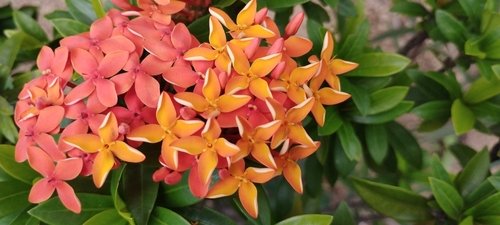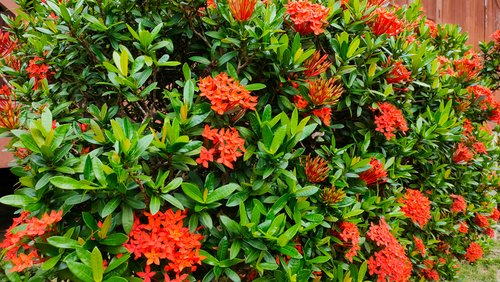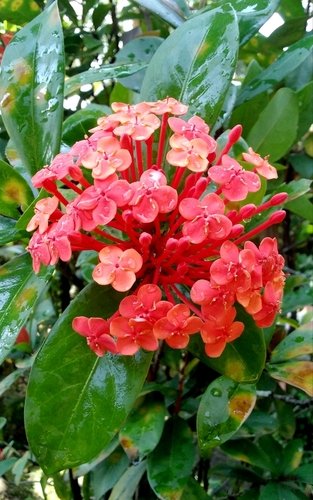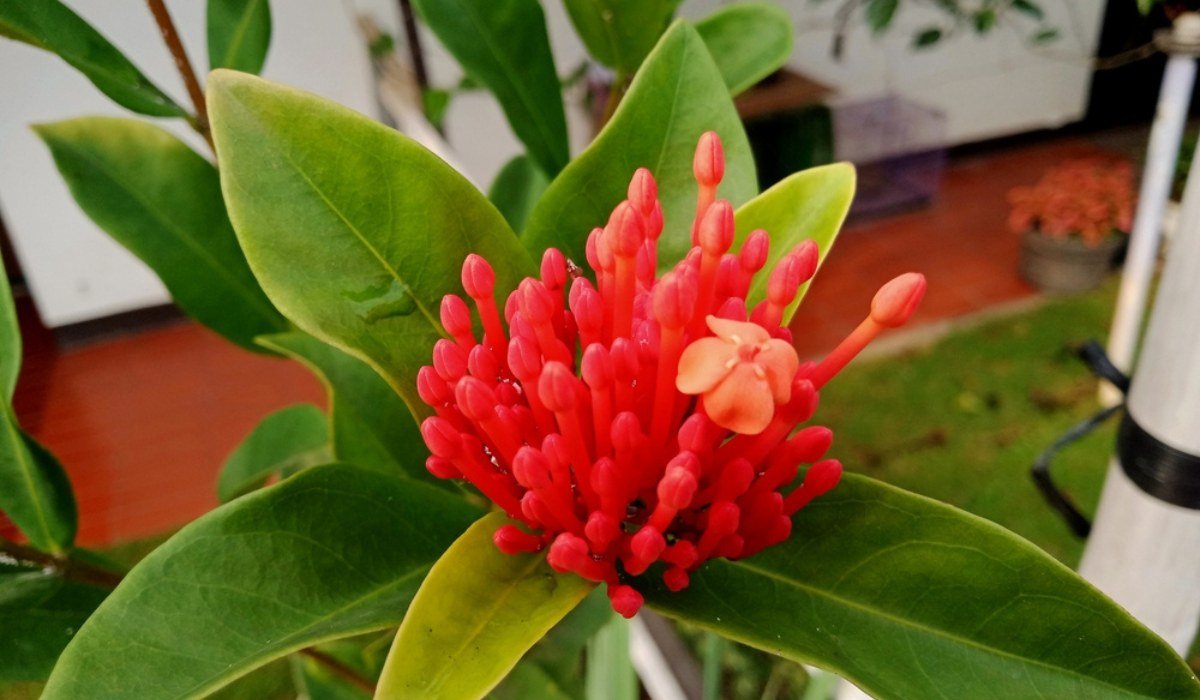The plant Ixora Chinensis, also called Chinese Ixora, is of the Rubiaceae family and is an attractive houseplant indigenous to southern China and Malaysia. It is also cited as Jungle Flame or Flame of the Woods.
Ixora Chinensis: Quick facts
| Name of species | Ixora Chinensis |
| Common names | Chinese Ixora, Flame tree of the woods, Scarlet Ixora, Bakora, Ishvaku |
| Botanical name | Ixora Chinensis |
| Plant family | Rubiaceae |
| Genus | Ixora |
| Plant form | Shrub |
| Flowering Time | Throughout the year but usually during the rains. |
| Height | Grow up to two feet |
| Growth rate | Fast |
| Pest Tolerance | Medium |
| pH level | Basic |
| Uses | Container plant, ornamental, hedge |
See also: How to grow and care for Oxalis Triangularis.
What is Plant Ixora Chinensis?
Ixora plants have tiny flower clusters that may make you think of the well-known hydrangea. But upon closer study, you will notice that they have smaller, more compact plant shapes and stems that are dense. Multi-stemmed, erect shrubs called Ixora plants can grow as long as two metres. Warm-toned, lovely flowers with a propensity to bloom all year long are also nectar-rich.
Speaking about their blossoms, these clusters are available in a wide range of colours, including red, pink, orange, and yellow. Additionally, the Chinese Ixora can enhance your house’s beauty, whether outside in your garden or in a clean container on your terrace, because of its evergreen habit and year-round flowering.
How to grow Ixora Chinensis at home?

How to propagate?
- Plant propagation for extras is not too difficult.
- In the spring or summer, all you have to do is trim a branch that is eight to ten cm long.
- The cut end of the branch should first be dipped in water, then in hormone rooting powder, and then into a moist potting mixture.
- Put the container entirely in plastic to increase humidity.
- If you continue to take good care of your Ixora plant cutting, roots should start to appear in about a month.
Lighting
- Ixora plant seeds should be dispersed (or an existing Ixora Chinensis should be replanted) in full sun to partial shade.
- To get more light throughout the summer, feel free to relocate any potted plants you have indoors.
- Place Ixora plants where they can receive at least six hours of sunlight each day because they prefer bright light. You must adhere to these requirements if you want to see this plant produce heavy blooms.
- If you notice that your Ixoras aren’t flowering correctly, you may need to move them to a warm greenhouse or sunroom.
Temperature tip
- Ixora plants can be challenging to grow. Even little changes in temperature or location can impact the plant’s growth.
- Due to their loathing of the cold, Chinese Ixora must be warm all year round.
- It is best to keep these plants between 16 and 24 °C and prevent them from chilly winds (particularly those coming from air conditioning vents)
- To avoid damaging it, please bring the plant inside as soon as the temperature drops below 16°C. It is when you set your potted Ixora Chinensis outside during the summer.
- Your plant may lose a lot of leaves as a result of the temperature change, but you can water it less frequently and avoid fertilising it altogether until spring returns.
Soil
- Both seeds and existing plants of the Ixora genus should be planted in soil that is rich in organic matter
- The ground should also have a bit of acidic pH.
- Ixora prefers soils with acid
- Fertilisers like vermicompost and cow dung manure can be added.
- To avoid the plant’s roots getting soggy, make sure the soil has adequate drainage.
Planting tip
Never grow Chinese Ixoras next to concrete structures or in cement containers. It is because the plant requires soil with a slightly acidic pH, and the cement will raise the pH of the soil and turn it alkaline.
Watering
- For Ixora Chinensis, keep in mind that damp soil is preferable to soggy soil.
- In the summer, it’s still a good idea to give your Ixora plants more frequent watering.
- Try to maintain and adhere to a watering schedule, and water your plants following the climate you are in
- It’s also a good idea to set the Chinese Ixora’s indoor container on a tray of moist pebbles because the plant prefers high humidity.
How to care for Ixora Chinensis?

Know how to fertilise
- Using a balanced fertiliser, such as NPK or DAP, would be sufficient. These are -release fertilisers, whereas the slow-release fertilisers are bone meal and neem Khali.
- Remember that Ixora plants prefer organically-rich soil, so be sure to give your potted ones a compost layer.
Tip on pests and diseases
- Ixora Chinensis plants are often not very hassled by pests or diseases. However, the occasional aphid or scale can cause sooty mould to form on the leaves
- Use a hard spray from the garden hose to eliminate any small green aphids or brown scales you spot on your plants.
- Nematodes may cause your plant’s slowing growth or wilting leaves. By covering the soil with a thick layer of mulch, you can prevent this.
How to prune?
- Even if pruning isn’t necessary, Ixora plants can be cut sometimes to control their size and shape and to get rid of the occasional flower or leaf that has fallen off.
- Cut away any branches that are broken or growing in the wrong direction
- Trim the biggest and oldest stems back a few centimetres from the ground to minimise the plant’s size without changing its natural shape.
In short, trim the plant’s tips once it has bloomed. The plant will look messy without proper pruning. To keep Ixora Chinensis in good form, practice routine pruning.
Growing indoors

If growing indoors or in a pot, you may always use your thumb or finger to feel the soil’s moisture level. Then, put your finger in the soil; if it seems dry, your Chinese Ixora probably needs water.
- Choosing the right pot is essential for preventing the over-watering of your Chinese Ixora.
- It is critical to choose a pot with many drainage holes since this will allow extra water to run out rather than collect at the bottom
- Additionally, the pot’s bottom air can enter the soil through drainage holes.
- Ixora Chinensis can be kept from getting too moist by using a terracotta pot or a similar container made of a porous material.
- Compared to a plastic container, terracotta and other materials enable water to drain from the soil more quickly.
Growing outdoors
- The amount of light your plant receives will significantly determine how frequently you should water Chinese Ixora if you are growing it outdoors.
- This plant will probably require more watering if it is in a sunny location as opposed to one that is in the shade
- You should also consider the sort of soil you use
- Sandy and loamy soils typically dry out considerably faster.
- To boost moisture retention, you can always add organic material to the soil, such as peat moss or compost.
Ixora Chinensis advantages and disadvantages
- Ixora Chinensis can be used for hypertension.
- Additionally, it is helpful for the bone marrow.
- The plant is used to treat abscesses, wounds, rheumatism, and bruises.
- Further, Ixora Chinensis can be utilised as a resolvent and anodyne.
- The parts of the flower must be avoided during pregnancy.Because of the vigorous growth and vibrant blossoms, the Chinese Ixora makes a good hedge plant and is suitable for planting in gardens and courtyards. Due to its attractiveness and low maintenance needs, it is often found in gardens. In addition, it does well in cottage gardens and frequently grows alongside other flowering plants like butterfly bushes and boxwood wintergreen. So, if you are looking for some great plants to enhance the beauty of your garden, then Ixora Chinensis is recommended.
FAQs
Which soil is best for Chinese Ixora?
Humus-rich, moist, but well-drained soil is ideal for Chinese Ixora growth.
What are the soil pH requirements for Chinese Ixora?
The soil pH requirements for Chinese Ixora are 5.6 to 6.0.
Is the Chinese Ixora indoor plant?
These can usually be grown indoors if placed close to a window or glass door in a warm, sunny area.
What's the humidity required for Ixora Chinensis?
There must be a lot of humidity. Use a cool-mist room humidifier for the plant if the relative humidity falls below 50%, or set the pot on a tray of moist pebbles.
Is Ixora Chinensis poisonous?
Ixora Chinensis is non-toxic to humans and animals.
Housing News Desk is the news desk of leading online real estate portal, Housing.com. Housing News Desk focuses on a variety of topics such as real estate laws, taxes, current news, property trends, home loans, rentals, décor, green homes, home improvement, etc. The main objective of the news desk, is to cover the real estate sector from the perspective of providing information that is useful to the end-user.
Facebook: https://www.facebook.com/housing.com/
Twitter: https://twitter.com/Housing
Email: [email protected]











